Nantes, France, a captivating city with medieval roots as a bustling port, thrived during the Renaissance with global trade. Resilient through wars and revolutions, it embraced industrialization, transforming into a vibrant cultural hub. A journey through time reveals its enduring significance in France’s heritage.
In this blog post, we explore the rich history of Nantes from Medieval Times to Modernity – from its seafaring roots to its many revolutionary moments. Read on and discover why exploring the history of Nantes is an enriching experience.
Nantes, France
Exploring the history of Nantes, France, is an enriching experience that unveils a captivating tale of evolution and resilience. From its medieval origins as a bustling port city, through the prosperous Renaissance era with global trade connections, to endure the challenges of wars and revolutions, Nantes has embraced change and growth.
Witnessing its transformation into a vibrant cultural hub and an industrial center offers a deeper understanding of its significance in shaping France’s heritage and its place in the world. The rich tapestry of Nantes’ history invites visitors to delve into a fascinating journey that leaves a lasting impression on their appreciation for this remarkable city.
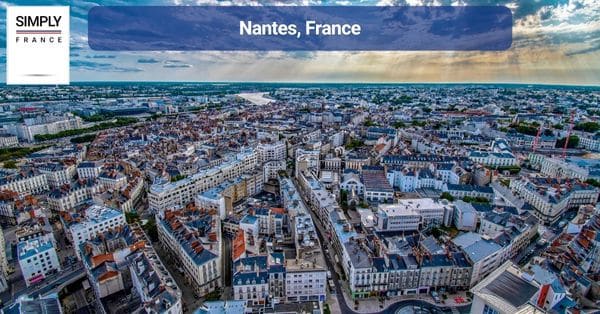
Medieval Times (1000s – 1500s)
In medieval times, Nantes was a significant port city and the capital of the Duchy of Brittany. It became a hub of commerce and culture, attracting merchants and artists from across Europe.
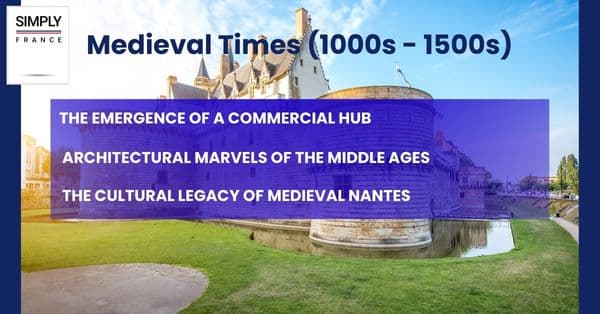
The Emergence of a Commercial Hub
During the 11th century, Nantes emerged as a major commercial center due to its strategic location along the Loire River. Merchants from Britain, Spain, and the Netherlands frequented the city, trading goods like wine, salt, and cloth. This period marked the beginning of Nantes’ prosperity, which continued throughout the Middle Ages.
Architectural Marvels of the Middle Ages
Nantes boasts several architectural gems dating back to the medieval era. The Castle of the Dukes of Brittany built in the 13th century, stands as a testament to the city’s medieval past. Its formidable walls, towers, and magnificent Grand Logis speak volumes about the architectural prowess of the time.
Another notable structure is the Cathedral of St. Peter and St. Paul. Construction began in the 15th century and took nearly 457 years to complete. With its intricate facades and stunning stained-glass windows, the cathedral is a masterpiece of Gothic architecture.
The Cultural Legacy of Medieval Nantes
The Middle Ages also saw Nantes develop into a cultural hotspot. The city was home to many troubadours – poet-musicians who played a crucial role in developing the Occitan language and culture. Their songs and poems, often revolving around themes of chivalry and courtly love, had a lasting impact on European literature.
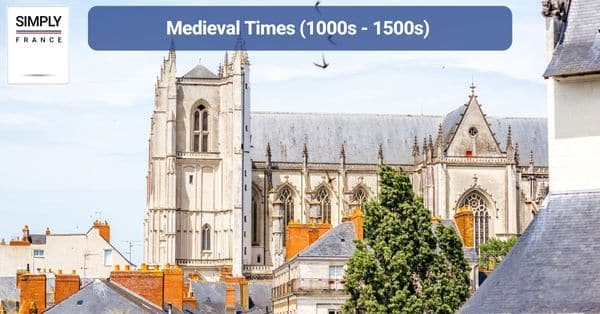
The Renaissance (1500s – 1700s)
The Renaissance in Nantes spanning from the 15th to the 17th centuries, marked a period of cultural and artistic flourishing. This epoch saw Nantes’ ascent to wealth through transatlantic trade connections, and it became a thriving center for arts, music, and literature. This section delves into Nantes’ role in the French Renaissance and its significant contributions to the cultural tapestry of the time.
The Dawn of the Renaissance in Nantes
The Renaissance, a period of great intellectual and artistic revival, brought about profound changes in the social, cultural, and political landscape of Nantes. This period marked a transition from the Middle Ages to modernity, making it a fascinating epoch in the city’s history.
The Influence of the Renaissance on Architecture
The Renaissance left an enduring legacy on the architecture of Nantes. Buildings from this era, characterized by their symmetry, proportion, and decorative elements, still stand today, serving as a testament to the city’s vibrant past. The Château des Ducs de Bretagne is one such example, blending Gothic and early Renaissance architectural styles.
Artistic Developments During the Renaissance
The Renaissance also saw a surge in artistic creativity in Nantes. Inspired by the humanist philosophy of the time, artists began to experiment with new techniques and perspectives, leading to the creation of some of the most iconic works of art. The Museum of Fine Arts in Nantes houses many such masterpieces from this era.
Intellectual Progress and the Renaissance
More than just a period of artistic and architectural innovation, the Renaissance in Nantes was a time of significant intellectual progress. It was during this time that the printing press was introduced to the city, revolutionizing the spread of knowledge and ideas.
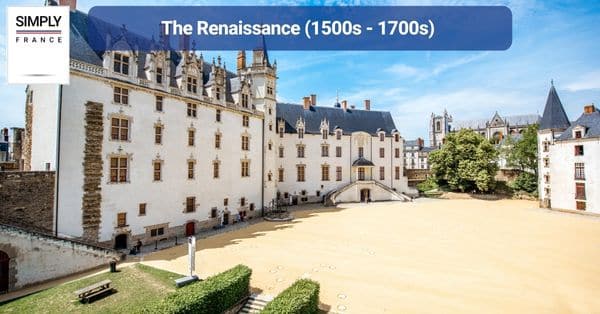
Wars and Revolutions (1700s – 1900s)
The period from the 17th to the 19th century was marked by significant wars and revolutions that profoundly impacted Nantes, France. This era saw the city endure the consequences of the French Revolution, experience the effects of World War I and witness periods of rebuilding and transformation. This section delves into this vibrant era, exploring the profound impact these events had on Nantes and its evolution.
The War of Spanish Succession (1701-1714)
At the dawn of the 18th century, Nantes found itself embroiled in the War of Spanish Succession. This conflict, which involved most of Europe’s major powers, was sparked by the death of the childless King Charles II of Spain. Although Nantes was largely spared direct combat, it felt the economic consequences as trade routes were disrupted and the city’s prosperity waned.
The French Revolution (1789-1799)
The French Revolution brought dramatic change to Nantes. As revolutionary fervor swept across France, Nantes became a hotbed of radical activity. The city played a key role in the counter-revolutionary War in the Vendée, serving as a base for the Revolutionary Army. The Reign of Terror also left a deep scar on Nantes, with the infamous Jean-Baptiste Carrier conducting the noyades – mass drownings of suspected counter-revolutionaries in the Loire River.
The Industrial Revolution (19th Century)
The 19th century marked a period of transformation for Nantes, driven by the Industrial Revolution. The city embraced industrialization, becoming a major center for shipbuilding, food processing, and machinery manufacturing. This shift brought significant economic growth but also social upheaval, as working conditions and urban living standards became pressing issues.
Franco-Prussian War (1870-1871) and the Paris Commune (1871)
The Franco-Prussian War and the subsequent Paris Commune had a profound impact on Nantes. As Prussian forces advanced on Paris, the French government sought refuge in Nantes. Although the war ended in defeat for France, it sparked a surge of patriotism that further fueled Nantes’ industrial development. The Paris Commune, a brief period of radical socialist control in the capital, also influenced political thinking in Nantes, contributing to the rise of the city’s powerful labor movement.
World War I and II (1914-1918, 1939-1945)
The two World Wars of the 20th century brought devastation to Nantes. The city was heavily bombed during both conflicts, suffering significant damage to its infrastructure and historic buildings. Despite these hardships, Nantes demonstrated remarkable resilience, rebuilding and reinventing itself in the post-war years.
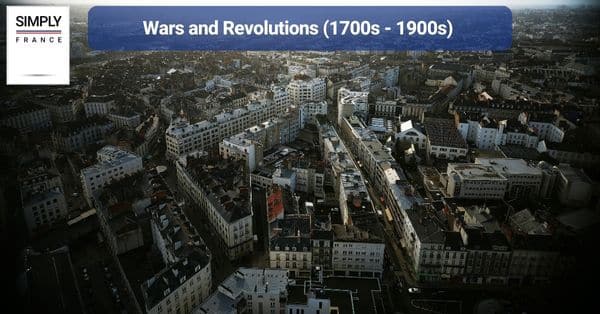
Modern Day (1900s – Present)
In the last century, Nantes has experienced a wealth of changes that have shaped it into the vibrant and dynamic city it is today. The post-industrial era has seen Nantes transform from a bustling port city to a hub for culture, innovation, and sustainability.

Industrial Decline and Urban Renewal
The 20th century brought significant challenges for Nantes. As with many cities in the industrialized world, Nantes faced economic decline in the mid-20th century as traditional industries such as shipbuilding began to falter.
However, this period also marked the beginning of a successful urban renewal project. The city embarked on a mission to reinvent itself, focusing on culture, creativity, and sustainability. Old warehouses were converted into cultural centers, and disused shipyards became spaces for art and music festivals. This transformation caught international attention, and today Nantes is renowned as a European capital of culture.
World War II and its Aftermath
Nantes’ history was deeply marked by World War II. The city was occupied by German forces and suffered heavy bombing. The post-war period was a time of reconstruction, both physically and socially. The city’s architecture bears the scars and the resilience of this period, with many modern buildings rising alongside restored historic ones.
Nantes Today: A City of Innovation and Sustainability
In the 21st century, Nantes has emerged as a leading city for innovation and sustainability. It was the first French city to reintroduce electric trams in the 1980s, paving the way for sustainable urban transport.
Nantes is also home to the “Green Capital” award, which recognizes its commitment to environmental sustainability. The city is known for its innovative projects such as the “Great Elephant,” a mechanical creature that roams the Isle of Nantes, symbolizing the city’s dedication to creativity and environmental consciousness.
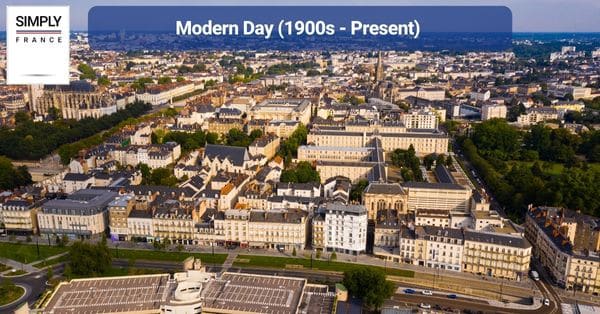
In conclusion
Nantes’ vibrant history has left a lasting legacy that can still be felt and seen all throughout the city today. From its Medieval buildings, Renaissance art, and Revolutionary monuments to its modern industries, Nantes is a constant reminder of its past.
Exploring the history of Nantes is not only an educational experience, but it’s also an opportunity to soak in the city’s unique blend of historical and modern vibes. So make sure you add this beautiful French destination to your bucket list!


